The Shetland sheepdog is an adorable dog breed that has been working with humans for thousands of years. Their fluffy coats, unique coloring, and loyal personalities combine to create excellent companions for young children, large families, or farmers needing support herding their livestock.
Shetland sheepdogs or shelties come in a variety of colors based on the genes they inherit from their parents. Understanding these genes makes it possible to determine the rarest coat colors for shelties.
This article explains how shelties get their coat colors, which are the rarest and most common colors, and what genes specifically relate to those colors.
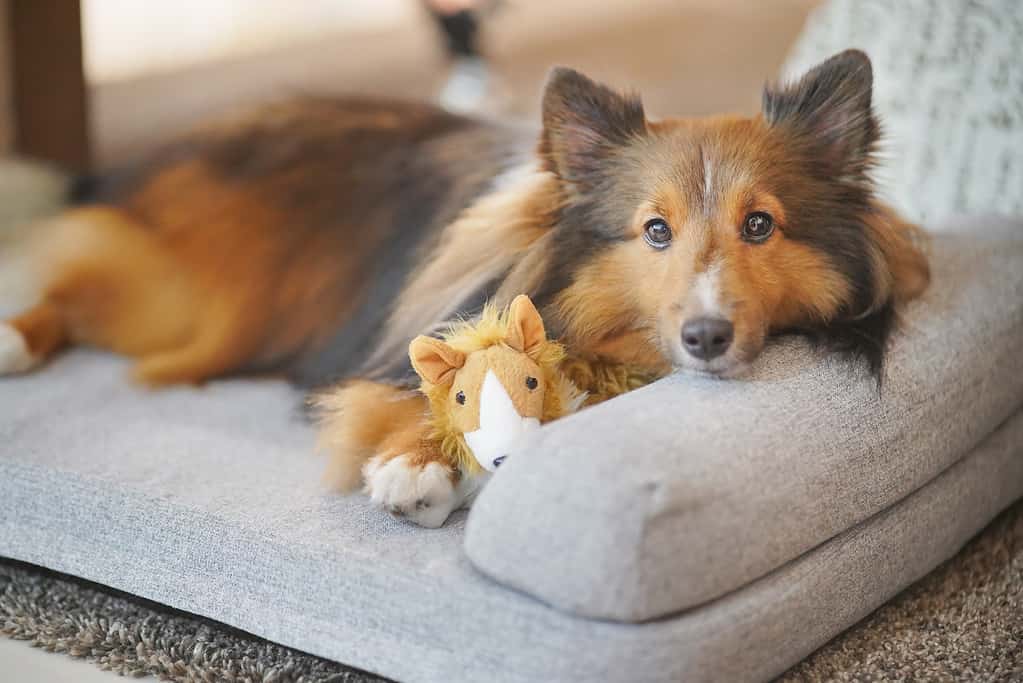
Shelties are wonderful companion dogs because they are easy to train and great with children.
©Jiras Pipatwasin/iStock via Getty Images
What Are Shelties
Shelties are medium-sized herding dogs. A herding dog is a group of working dogs bred to gather, herd, and protect livestock like sheep, ponies, and poultry. They were originally bred on the Rocky Shetland Islands, an archipelago in Scotland near the Faroe Islands and Norway.
Shelties are medium-sized, reaching 13-16 inches high and weighing 15-25 pounds. They can live between 12-14 years when provided with a healthy diet, proper grooming needs, and attentive health care.
Shelties have a double coat, protecting them from the cold weather and brittle winter chills. A healthy sheltie coat is thick, long, free of knots, and feels smooth and light.
Families love owning shelties because they are very energetic, playful, extremely intelligent, easy to train, and obedient with consistent rules and commands. They are excellent dogs to watch and protect young children, sometimes herding them into their rooms or around the backyard on instinct to keep them safe.
Colors of Shelties
Shelties have a unique color scheme among dogs and can be easily recognized by their long snouts and iconic patterns. Most shelties have a “traditional Irish pattern” where the chest and legs are covered in white fur, and the cheeks, throat, eyes, ears, legs, and tail are a mixture of the same uniform colors.
Sheltie’s base coat layers are typically tan, black, or sable. Depending on genetics, they may have some blue or merle sprinkled along their bodies.
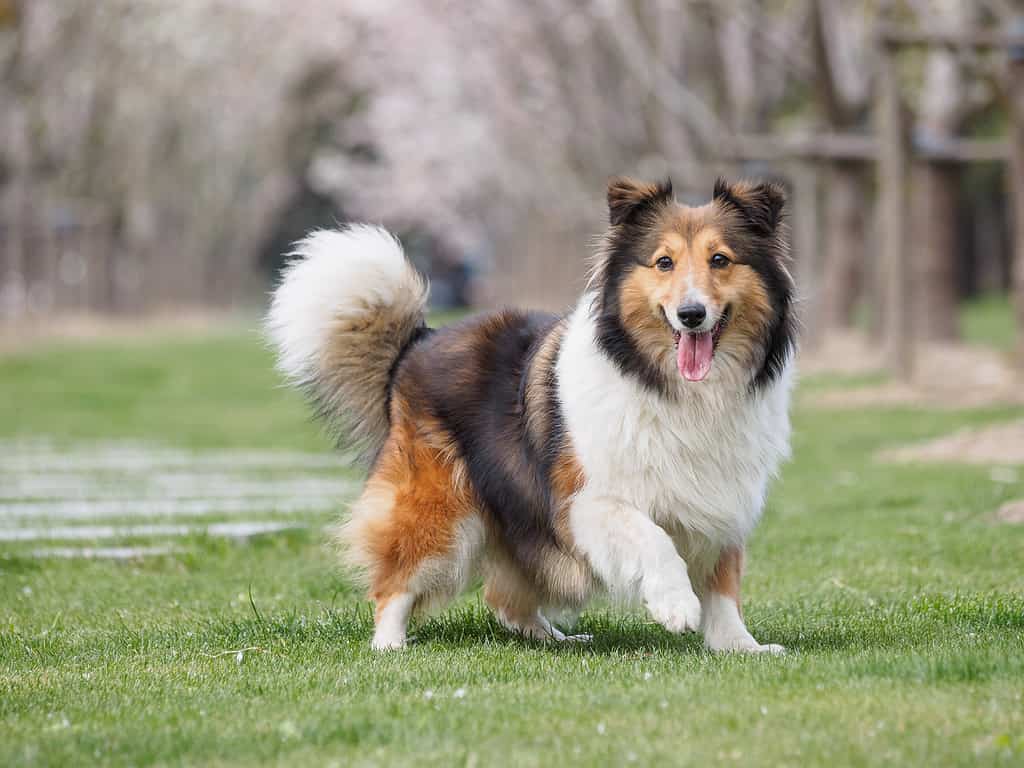
Shelties with a traditional Irish pattern are easily identified with their chest fur and unique face patterns.
©yanjf/iStock via Getty Images
In total, there are six primary colors found in shelties:
- Pure sable
- Mahogany sable
- Tri-color
- Blue Merle
- Bi-Black
- Bi-Blue
Because of their double-layered coat, shelties can have patterns within their coat that are not seen from the outside. The undercoat may possess a hint of black or tan while the outside is white or merle.
A sheltie’s coat color may change depending on the recessive genes inherited by the parents. A young sheltie may be born gray and turn tan or merle over time. While they mature, the tan color may turn black due to the recessive genes blooming as they reach old age.
Rarest to Most Common Sheltie Colors
A fun part of owning a sheltie is not knowing what colors their coat may become over time. They are a lovely dog breed with unique genetics that can have unique patterns outside of the traditional Irish pattern associated with the breed.
Here is a list of the sheltie coat colors from rarest to most common.
Double Merle

Shelties with the double merle coat are extremely rare. Their coats can turn into a bi-blue or blue merle.
©Mayabun/iStock via Getty Images
Double merle is one of the rarest sheltie color patterns. Shelties with a double merle coat have a mostly white coat with hints of gray or black. The pattern is similar to albino coloring where the coat embodies the full color spectrum.
It is a rare color because it is technically a mutation of two genes merging to create a pale or albino-like color. There is a 25% chance a sheltie will have a double merle coat if both parents are blue merles.
Unfortunately, double merle shelties commonly have health issues because they inherited recessive genes from both parents, and the genes mutated which leads to weaker immune systems. Double merle shelties can still live a long and healthy life, but pet parents must be aware they are at a higher risk for health issues as they age.
Bi-Blue
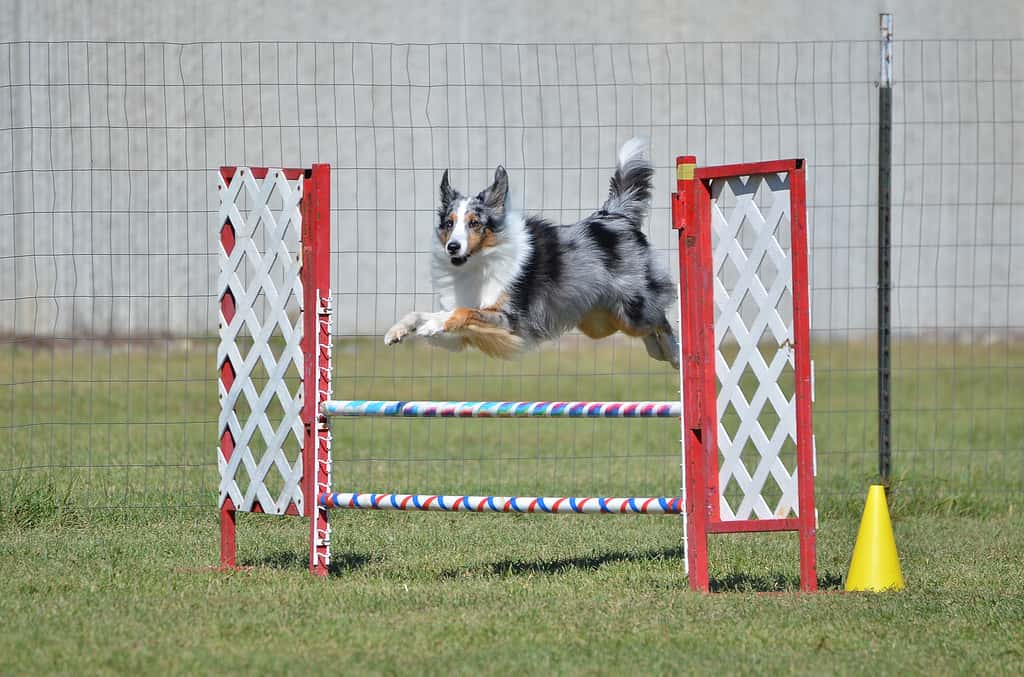
Shelties are popular show dogs for their long hair, obedience, and grace when running and working.
©herreid/iStock via Getty Images
The bi-blue color scheme is the rarest color for shelties. Bi-blue shelties are predominantly blue and white with the common Irish pattern across their body. Some bi-blue shelties will have degrees of merle within the double coat, but that depends on the genetics of the specific dog.
Bi is the prefix meaning two, which describes the breed color. Shelties will only be considered bi-blue when they possess a nearly equal amount of blue and white in their coat. Other colors emerging or developing in the coat will reclassify them as tricolor or merle.
A sheltie will emerge with the bi-blue coloring when a bi-black sheltie mates with a merle sheltie. The chances of their pups being born with bi-blue colors are slim but possible.
Sheltie breeders are capable of increasing the chances of producing a bi-blue sheltie, but the cost may be more than regular color patterns due to the complexity and random chance of one forming. Additionally, some shelties’ coats change over time. The bi-blue can become bi-black or merle, losing the unique color scheme.
Bi-Black
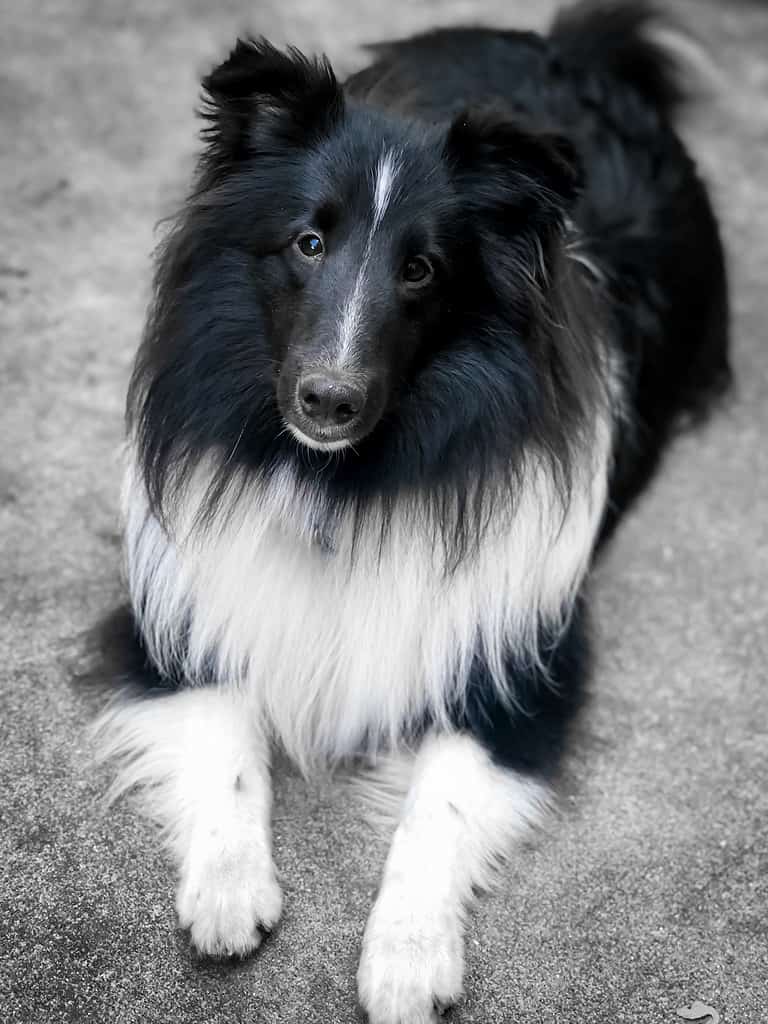
Bi-black sheltie coats are heavy with black and white tones with little or no sable in their fur.
©Rachel Fein/iStock via Getty Images
This is the second or third rarest type of coat a sheltie can have. Like bi-blue, bi-black dogs only have two colors. The coat is primarily a combination of black and white, with the traditional Irish pattern or merle.
Sometimes, bi-black shelties will have hints of brown and tan within the undercoat. Black is a dominant color for dog breeds to have, making this coat color more possible than the bi-blue variation. Bi-blue coats may become a bi-black coat over time if the genes focused on the black color overtake the blue genes.
Blue Merle
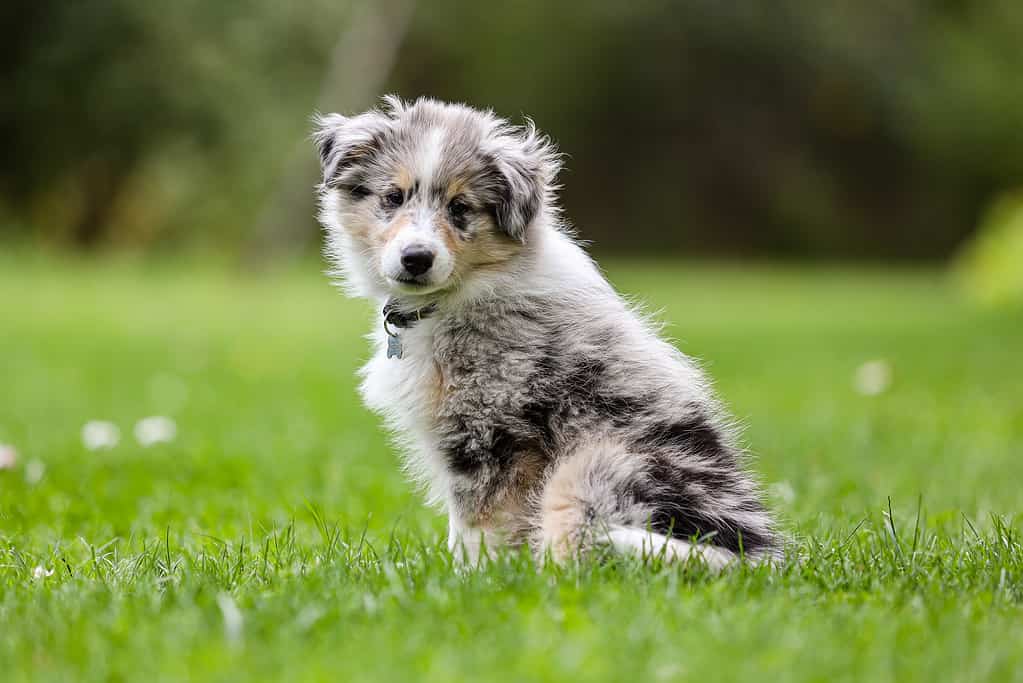
Puppy blue merle shelties do not have the Irish pattern due to more spotting and dilution in their coats.
©Artūrs Stiebriņš/iStock via Getty Images
Blue merle sheltie coats are a combination of blue, gray, silver, and white in their fur. The dominant blue and gray genes stand out while the merle pattern encompasses the dog’s entire body.
Dog shows, breeders, and sheltie fanatics debate whether a blue merle sheltie is considered tri-color or not. Blue merle is a separate category, but the breed does possess three distinct colors that cover the body evenly. However, blue shading is a recessive gene. It is classified by itself to stand out from the more distinct tri-color.
Tri-Color
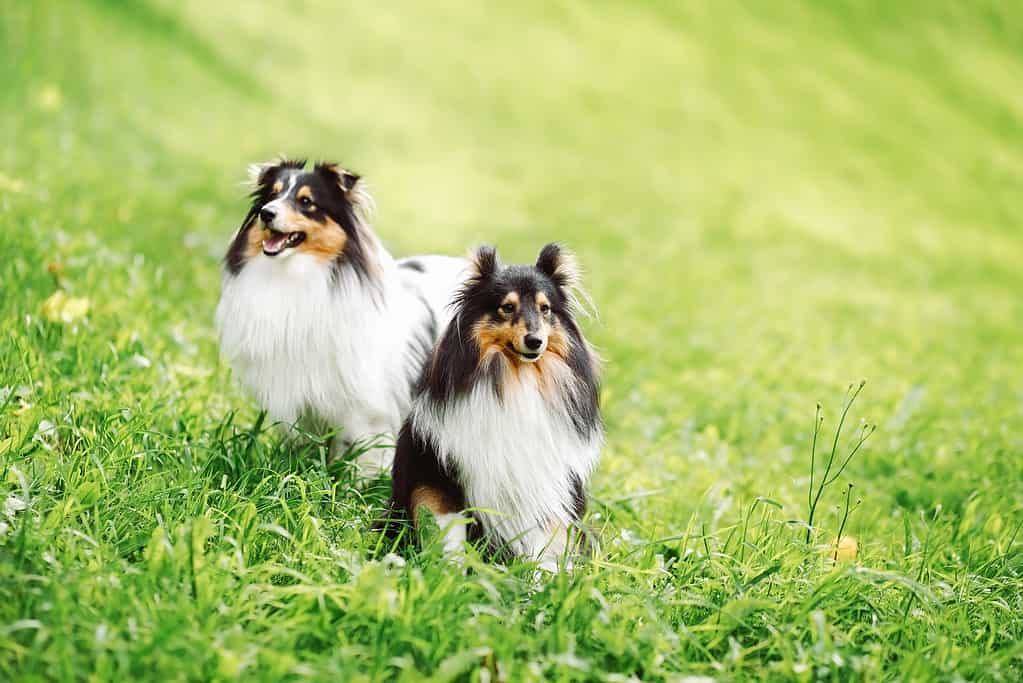
The tri-color scheme is the third most common fur type for Shetland sheepdogs.
©Annaartday/iStock via Getty Images
Tri-color shelties have a combination of black, white, and tan easily recognized across the entire body. These shelties have the trademark Irish pattern again with long and thick tufts of hair covering their chest and feet, with accent colors matching the face and legs.
It is very common for shelties to be born with the tri-color scheme since it is a popular color many owners and farmers wanted.
Mahogany Sable

Shelties need to be brushed on a daily basis to remove any knots and keep their undercoat healthy.
©Lidia Belyaeva/iStock via Getty Images
Mahogany sable shelties have dark fur, similar to chestnut or mahogany with layers of black and deep brown within the undercoat. This color scheme is also a shaded sheltie or shaded sable.
Mahogany sable shelties have a higher chance of their coats changing over time due to the pigment in their hair developing differently. They can turn into pure sable on the outside, while still possessing black coloring in the undercoat.
Pure Sable

Tan and pure shelties are the most common and popular color for the breed.
©molka/iStock via Getty Images
Pure sable shelties are the classic and most common coat color for shelties. Shelties are light tan, gold, and ginger colored with varying degrees of shading to match the traditional Irish pattern.
Puppy shelties can be born gray at first, with their tan color developing as they lose their puppy coat and reach adolescence. Depending on the genetics provided by the parents, pure sable shelties may have hints of black or white spots in their coats. It does not categorize them as tri-color or mahogany because the coat is still predominantly sable.
What Causes Rare Sheltie Colors
There are 11 types of specific genes shelties have to determine their color. These genes can be dominant or recessive.
Remember back in high school biology when the teacher drew a Punnett square on the board to illustrate how human parents give specific attributes to their offspring? Shelties work similarly, except with 11 different types of genes.
As a refresher:
- Alleles are one or two pieces of DNA given a specific (single or segment) genetic attribute.
- Dominant genes are alleles that overrule other alleles.
- Recessive genes are alleles that are being suppressed or masked by stronger alleles.
The dominant allele will determine the specific inherited trait. In this case, it will determine the sheltie’s coat color.
The American Shetland Sheepdog Association has excellent records and documentation to help explain how shelties obtain their coat coloring in more detail, but here is a simple breakdown.
Sheltie Coat Color Genes
| Gene Series | Gene Name | Associated Characteristic |
| A Series | Agouti | Determines the amount of tan and sable within the coat |
| B Series | Brown | Determines levels of black or brown in the coat |
| C Series | Chinchilla | Possessing the full-color spectrum, the primary gene that may turn sheltie all-white or albino |
| D Series | Dilution | Dilutes the black pigment to be in clumps on the coat. Turns the black fur gray or blue. |
| E Series | Extension | Controls the amount of pigment on the coat. Works alongside the A and H series. |
| G Series | Graying | Determines the chances of the sheltie turning gray over time |
| H Series | Harlequin | Controls the amount of tan pigment to fit different patterns. May only react when the M series is present |
| K Series | Dominant Black | Works with the A and B genes to determine the amount of black or tan in the coat. This was not originally discovered with the other genes and was introduced later. |
| M Series | Merle | Affects the black pigment in shelties, turning them gray, merle, or bi-blue. Very slim chance of mutation to create double merle coats. |
| S Series | Spotting | Affects the number of white markings or spots found within the coat. |
| T Series | Tickling | Determines the number of colored flecks or spots in places where there is white. |
Shelties are amazing dogs that come in a variety of colors and patterns. The most popular colors and styles are sable, mahogany, or tri-colored with the traditional Irish pattern. The rarest colors are bi-blue or double merle, due to the nature of the recessive genes or mutation of it emerging. Regardless of their color, these pups are a lovely breed that bring a bright smile to their owners’ faces.
The photo featured at the top of this post is © Lisjatina/Shutterstock.com
Ready to discover the top 10 cutest dog breeds in the entire world?
How about the fastest dogs, the largest dogs and those that are -- quite frankly -- just the kindest dogs on the planet? Each day, AZ Animals sends out lists just like this to our thousands of email subscribers. And the best part? It's FREE. Join today by entering your email below.
Thank you for reading! Have some feedback for us? Contact the AZ Animals editorial team.







